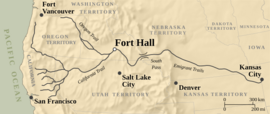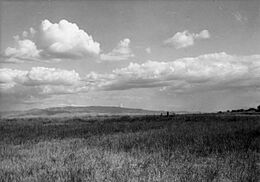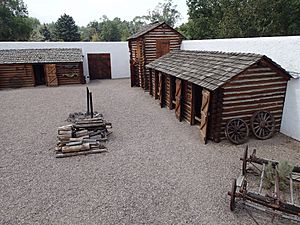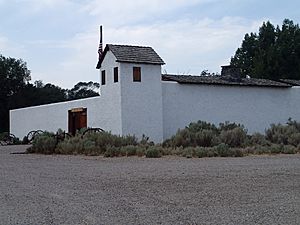Fort Hall facts for kids
Quick facts for kids Fort Hall |
|
|---|---|
| Fur Trade Outpost | |
 |
|
| Constructed: | 1834 |
| Company built: | Nathaniel Jarvis Wyeth |
| Location: | Fort Hall, Idaho, U.S. |
| Continent: | North America |
| Later Ownership: | 1837: Hudson's Bay Company 1846: United States Army |
| Abandoned: | By 1863 |
|
Fort Hall
|
|

Marker at the first Fort Hall site, 1958
|
|
| Lua error in Module:Location_map at line 420: attempt to index field 'wikibase' (a nil value). | |
| Location | 11 mi. W of Fort Hall, Fort Hall Indian Reservation |
| Built | 1834 |
| NRHP reference No. | 66000306 |
| Significant dates | |
| Added to NRHP | October 15, 1964 |
| Designated NHL | January 20, 1961 |
|
Fort Hall Site
Fort Hall (United States Army, 1873-1883) |
|
| Lua error in Module:Location_map at line 420: attempt to index field 'wikibase' (a nil value). | |
| Nearest city | Blackfoot, Idaho |
| Area | 160 acres (65 ha) |
| Built | 1870 |
| NRHP reference No. | 74000732 |
| Added to NRHP | November 21, 1974 |
Fort Hall was an important fort in the Western United States. It was first built in 1834 by Nathaniel Jarvis Wyeth as a place to trade furs. The fort was located on the Snake River in what is now southeastern Idaho.
Wyeth was a smart businessman from Boston. He also built another trading post in Oregon. But in 1837, he couldn't compete with the powerful British Hudson's Bay Company. So, he sold both his forts to them.
After 1846, when the land became part of the United States, Fort Hall became a key stop for people traveling west. It was on the famous Oregon Trail. Many thousands of pioneers passed through Fort Hall on their way to new homes.
Later, in the 1860s, Fort Hall was a main stop for mail and stagecoaches. A "New Fort Hall" was built in 1870 to help protect travelers. Today, no original buildings remain at either site. However, the first Fort Hall site is a National Historic Landmark.
Contents
The Story of Fort Hall
This area was home to different groups of indigenous peoples for a very long time. The Shoshone and Bannock peoples lived here for centuries. They used horses to hunt bison and move around. French and British traders had met them before American explorers arrived.
Building the First Fort
In the early 1830s, people in Boston became interested in making money in the Oregon Country. This was a large area in the Northwest that both Britain and the United States claimed. Nathaniel Jarvis Wyeth decided to go on his own expedition in 1832. He wanted to set up a fishing and trading post on the Columbia River. He also planned to trade goods with trappers in the Rocky Mountains.
In 1834, Wyeth found that a fur company he had a deal with backed out. This left him with many goods. So, he decided to travel west to the Snake River area in what is now Idaho. There, he built wooden storehouses and a fence around them. He finished the fort on July 31, 1834. Wyeth named it Fort Hall after a main investor, Henry Hall. This was the only outpost built by Americans in that part of the Oregon Country.
The Hudson's Bay Company (HBC) was a very strong British company. They had a lot of control over the fur trade in the Oregon Country. The HBC made it hard for smaller American companies like Wyeth's to succeed. Because of this, Wyeth sold both his forts to the HBC in 1837. The fur trade was also slowing down because there were fewer animals and people in Europe wanted fewer furs.
The Oregon Trail and Westward Travel
The HBC managers at Fort Hall didn't want American pioneers to settle in Oregon. They even tried to discourage them by showing them abandoned wagons. But in 1843, a missionary named Marcus Whitman led a wagon train past Fort Hall. His reports encouraged many more settlers to head west.
The idea of "manifest destiny" grew in the United States. This was the belief that Americans were meant to expand across the continent. This led to more and more settlers moving west. In 1846, the Oregon Treaty set the border between the United States and Canada. Fort Hall then officially became part of the U.S.
Fort Hall became a very important stop on the Oregon Trail. It was a place where hundreds of thousands of pioneers could rest and get supplies. It was also a trading post for mountain men and the local Shoshone people. From 1849 to 1850, the U.S. Army had a camp nearby to protect the trail.
Later Years and New Fort Hall
When the American Civil War started in 1861, fewer people traveled west. The Army left Fort Hall. In 1863, floods from the Snake River washed away the original fort. It was rebuilt in 1864, a little north of the first spot. Parts of the old fort were used to build a new station for stagecoaches. But this new site was also abandoned the next year.
In 1867, the United States created the Fort Hall Indian Reservation. This was for the Shoshone and Bannock peoples, whose lands had been taken by settlers. The town of Fort Hall grew about 11 miles east of the old trading post. Both are now inside the reservation. In 1961, the site of the first Fort Hall was named a National Historic Landmark.
Today, a replica of the original Fort Hall was built in the 1960s in Pocatello, about 30 miles away. It is now a museum that people can visit.
New Fort Hall (1870)
On May 27, 1870, the U.S. Army built another military fort. This "New Fort Hall" was about 25 miles northeast of the old one. Soldiers were stationed there to protect stagecoach travelers, the U.S. mail, and workers going to mining areas. The Army left this fort on June 11, 1883.
The government then gave the land and buildings to the Bureau of Indian Affairs (BIA). The buildings were used as an Indian boarding school. These schools aimed to teach Native American children English and American culture. The buildings were later moved to another spot on the reservation.
No original buildings remain at either the old or new Fort Hall sites. The 1870 site is also listed on the National Register of Historic Places.
See also



